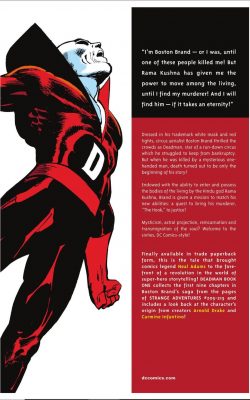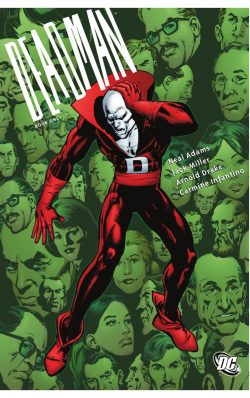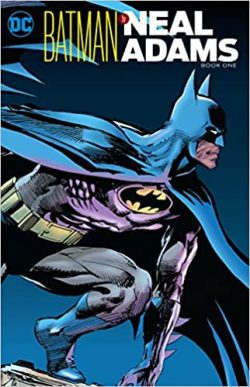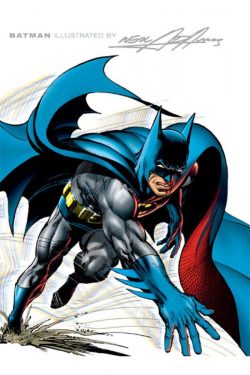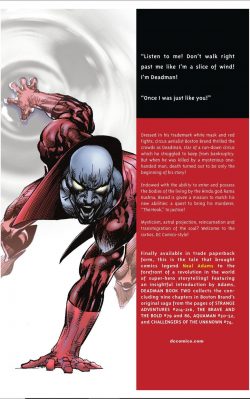
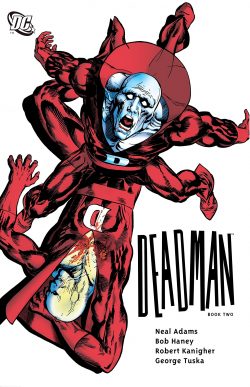
By Arnold Drake, Jack Miller, Bob Haney, Dennis O’Neil, Carmine Infantino, Neal Adams, George Tuska, George Roussos & various (DC Comics)
ISBN: 978-1-4012-3388-4 (TPB/Digital edition)
As the 1960s ended, a massive superhero boom became a slow but certain bust, with formerly major successes no longer able to find enough readers to keep them alive. The appetite for superheroes was paling in favour of resurgent traditional genres. One rational editorial response was to reshape costumed characters to fit evolving contemporary tastes.
Publishers swiftly changed gears with even staid, cautious DC reacting rapidly: making over masked adventurers to fit a new landscape. Newly revised, revived features included roving mystic troubleshooter The Phantom Stranger and Golden Age colossus The Spectre, whilst established genres spawned atrocity-faced WWII spy Unknown Soldier and bounty hunter Jonah Hex, western avenger El Diablo and game-changing monster hero Swamp Thing, the vanguard of a torrent of new formats, anthologies and concepts.
Moreover, supernatural themes were shoehorned into superhero titles weathering the trend-storm. Arguably, the moment of surrender and change had arrived with the creation of Boston Brand in the autumn of “The Summer of Love”, when venerable science fiction anthology Strange Adventures was abruptly retooled as the haunted home of an angry ghost…
Without fanfare or warning, Deadman debuted in #205 (cover-dated October 1967), with this second collection (of five) proving that changing times and tastes demanded different defenders. This was one champion who was infinitely adaptable…
The previous volume revealed how the ghostly grouch was born by assassination and how his picaresque journey was primary steered by youthful, idealistic iconoclast Neal Adams. He was born on June 15th 1941 at Governors Island, New York City. The family were career military and Neal grew up on bases across the world. In the late 1950s, he studied at the High School of Industrial Art in Manhattan, graduating in 1959.
As the turbulent, Sixties began, he was a budding illustrator working in advertising, ghosting newspaper strips and seeking to break into comics. Whilst pursuing a career in “real” and “commercial” art, he did pages for Joe Simon at Archie Comics (The Fly and that red-headed kid, too) before becoming one of the youngest artists to co-create/illustrate a major licensed newspaper strip (Ben Casey – based on a popular TV medical drama). The neophyte’s attempts to break in at DC were not so successful…
Comic book fascination never faded, and as the decade progressed, Adams drifted back to National/DC: creating covers as inker or penciller. His chance came via anthological war comics:,he eventually found himself at the vanguard of a revolution in pictorial storytelling…
He made such a mark that decades later, DC celebrated his contributions by reprinting every piece of work Adams ever did for them in commemorative collections. Sadly, we’re still awaiting a definitive book of his horror comics and covers, and will probably never see his sterling efforts on licensed titles like Hot Wheels, The Adventures of Bob Hope and The Adventures of Jerry Lewis. That’s a real shame: they all display his wry facility for gag staging and personal drama…
Moreover, Adams was a tireless campaigner for creators’ rights, whose efforts finally secured some long-ignored liberties and rewards for the formerly invisible stars of comic books…
Preceded by Adams’ introduction ‘Why I Chose Deadman as My Project on my Summer Vacation’ – detailing the transition from Carmine Infantino to Adams on the series and its abrupt cancellation – the afterlife of a reluctant and selfish spectral stalwart resumes with Brave & Bold #79 (August/September 1968): heralding Adams’ assumption of interior art duties on that title and launching a groundbreaking run rewriting the rulebook for strip illustration.
Written by Bob Haney, ‘The Track of the Hook’ paired the Gotham Guardian with a justice-obsessed ghost. Former trapeze artist Brand was hunting his own killer, and his earthy human tragedy elevated Batman’s costume theatrics into deeper, more mature realms of drama and action. It was probably mainstream superhero fandom’s first glimpse of the ghost…
During this period, Adams was writing and illustrating Brand’s solo stories in Strange Adventures and although his consultation of the World’s Greatest Detective bore little useful progress it had provided the lonely ghost with a true point of human contact…
As a living “Deadman”, Brand had been star attraction of Hills Circus: lover of its reluctant owner Lorna Carling, and a secret guardian for the misfits it employed. That makeshift “family” included simple-minded strongman Tiny and Asian mystic Vashnu, but also had a few bad eggs too…
One fateful night, as soon as he started his act – 40 feet up and without a net – someone put a rifle slug into Brand’s heart…
Despite being dead before he hit the ground, Brand was scared and furious. Nobody could see or hear him screaming, and Vashnu babbled on that he was the chosen of Rama Kushna – the spirit of the universe. The unbelievable hokum proved horribly true as the entity contacted him, telling Brand he would walk among men until he found his killer…
The sentence came with some advantages: he was invisible, untouchable, immune to the laws of physics and able to possess living bodies and drive them like a car. His only clue was that witnesses claimed that a man with a hook had shot him…
Outraged, still disbelieving and seemingly stuck forever in the ghastly make-up and outfit of his performing persona, Boston began a random investigation of everyone he could think of who might want him gone. Gradually, small petty miscreants and human-scaled sins gave way to a fantastic global conspiracy…
Early stories focused on people worn by Brand in episodic encounters mimicking the protagonist of contemporary TV series The Fugitive – and by extension, Victor Hugo’s Les Misérables. That search for personal justice took him all across America to the benefit of many people in crisis but, as pieces fitted together, Brand learned he had been singled out for a dark destiny…
Back in Strange Adventures # 214 (cover-dated September/October 1968). Robert Kanigher scripted To Haunt a Killer’ as Brand is seduced by loneliness into sharing the romantic experiences of Phil and his lovely girlfriend Ruth. That salacious intrusion sours once Brand discovers his new meat suit is a hitman and his overreaction almost cost innocent Ruth everything…
When Adams returns to full control in #215, the narrative arc takes a huge leap forward as ‘A New Lease on Death’ accidentally drops his killer in his lap. Witnessing a murder, Deadman trails the shooter all the way to Hong Kong where he exposes an ancient, super-advanced League of Assassins and discovers the truly trivial reason for his own extinction…
Furiously questioning ‘Can Vengeance Be So Hollow?’, Brand meets for the first time killer mystic The Sensei – a master murderer who has dealt with ghosts before and experiences the end of the Hook…
When the sinister sage executes Boston’s death-long quarry, Rama Kushna asks if a balance has been struck before capitalising on Brand’s furious negative response. Boston demands true justice for everyone and inadvertently elects himself the agent of its enactment in ‘But I Still Exist’…
The drama opens Strange Adventures #216 (January/February 1969), as the grim ghost seeks to disrupt the Sensei’s next scheme: the violent erasure of a fanciful Tibetan Shangri La. Nanda Parbat is a sanctuary for the wicked where his murderous recruits and other fallen folk live in inexplicable peace, harmony and safety. Such a paradise is bad for the business of murder…
Deadman’s efforts to save the city from invasion initially falter when he flies in and suddenly becomes a living, breathing person again…
And that’s where the story ended as his Strange Adventures run ended without warning. The next issue began reprints of Adam Strange and The Atomic Knights as the title reverted to is sci fi roots…
Although his own series had stalled, Deadman stuck around as a perennial walk-on (float-on?) star in many titles, beginning with a return engagement with Batman as the year ended. The Brave & the Bold #86 (October/November 1969) found Boston Brand back in Gotham City, where a string of civilian strangers inexplicably targeted the Caped Crimebuster. The “World’s Greatest Detective” soon deduced that they were possessed by his former ally and that ‘You Can’t Hide from a Deadman!’
Scripted by Haney, the captivating epic of death, redemption and resurrection pulled together all the floating strands from Deadman’s anticlimactic last issue in a classic clash that became a cornerstone of Bat-mythology forever after. Here, Adams’ concepts and art revealed how Nanda Parbat was under attack by the Sensei’s forces, and how Brand had been briefly brainwashed to attack the Gotham Guardian, in advance of a last-ditch defence of the holy city by the Dark Knight and Deadman’s possessed twin brother Cleveland Brand…
Deadman rematerialized mere months later in a triptych of back-up tales interwoven into a larger but no-less-revolutionary Aquaman storyline (for the full story see Aquaman: Deadly Waters link please) wherein the Sea King is despatched to a Microverse by aliens working with super villain Ocean Master: a plot accidentally uncovered by Brand, when guilt drags him from a life of solid recuperation back to the intangible quest for cosmic justice…
Here, from Aquaman #50-52 (spanning March/April – July/August 1970), ‘Deadman Rides Again!’ in supplemental tales written and illustrated by Adams: a complex braided crossover as Aquaman endures bizarre threats and incomprehensible rituals in his exile realm, whilst Brand acts invisibly and intangibly to save the hero and prevent an alien invasion.
‘The World Cannot Wait for a Deadman’ sees the spirit flitting between dimensions with shapeshifting enigma Tatsinda, before parallel plots converge and complete when ‘Never Underestimate a Deadman’ sees the extraterrestrials beaten by the ghost and his new pal…
Deadman’s harrowing haunting dramas pause – for now – with another non-team-up from Challengers of the Unknown #74 (cover-dated June/July 1970). A far eerier affair tailored to the rise in supernatural terror tales, ‘To Call a Deadman’ is written by Dennis O’Neil, with George Tuska limning scenes featuring the still-breathing “Death-Cheaters”, whilst Adams illustrated those portions focussed on Brand as he imperceptibly aids them in thwarting an ethereal psychic kidnapper seeking to steal a little girl’s spirit. The chilling thriller also guest-stars hardboiled private eye Jonny Double and everyone is needed to defeat the ghastly menace…
With groundbreaking covers by Adams and Biographies of key ‘Contributors’ Adams, Haney, Kanigher, O’Neil and Tuska, this graphic grimoire perfectly captures the tone of an era in transition through a delirious run of comics masterpieces that no ardent art lover or fanatical fear aficionado can do without.
© 1968, 1969, 1970, 2012 DC Comics. All Rights Reserved.

